Successful and complex ventures, such as winning a football championship (when no one believes in your “underperforming” team), finding a missing girl in the woods (when many abandon all hope), or reinventing your workplace for the sake of innovation (when wise-men tell you that’s stupid and impossible), can be completed with the right combination of (purposeful) contributions carried out by a cohort of self-driven and inspired actors. This hack shows you how.
“Charlie is a brilliant professional.” –Recounted Anna, his proud and supportive wife, with a big smile during a small party with some old-time friends. – “Last month he got a big promotion, corner office included, and he was named employee of the year, again!”
“And yet…” – Charlie added in a laconic tone- “I decided to quit that job on Monday.”
That Job?
What happened here? Was Charlie drunk, has he lost his mind, or is there something else?
Like many others, Charlie was tired of playing along. Yes, he consequently hit the numbers, “but to what end?”-He thought-. In Charlie’s opinion, to meet results just to increase the value of the company (being his implicit mission) was not enough for his soul. He was fighting someone else’s fight and pursuing someone else’s dream, while postponing his inner call: to become a world class runner and promote running as the healthiest and funniest way to move around big cities. Although he was an accountant and worked in a nationwide trucking company, he got once an epiphany on how to serve local communities of runners around the country throughout their distribution channels. His boss never listened to him and suggested him to stick into his analytical role and let “idea guys” take care of creative stuff. Truth was that Charlie felt extremely bored of his job.
When performance appraisals came, Charlie scored outstandingly. “Of course I fared well in the review,” – He confided – “we were aiming too low… I was aiming too low. My tasks were full of routines and standards, deprived of any grain of challenge. Can you imagine how depressed Usain Bolt would be if he was lured to hang up his shoes, his records, and all his glory in exchange of a dental plan, a decent salary, and a 9-to-5 workday? Well, I was that depressed!”
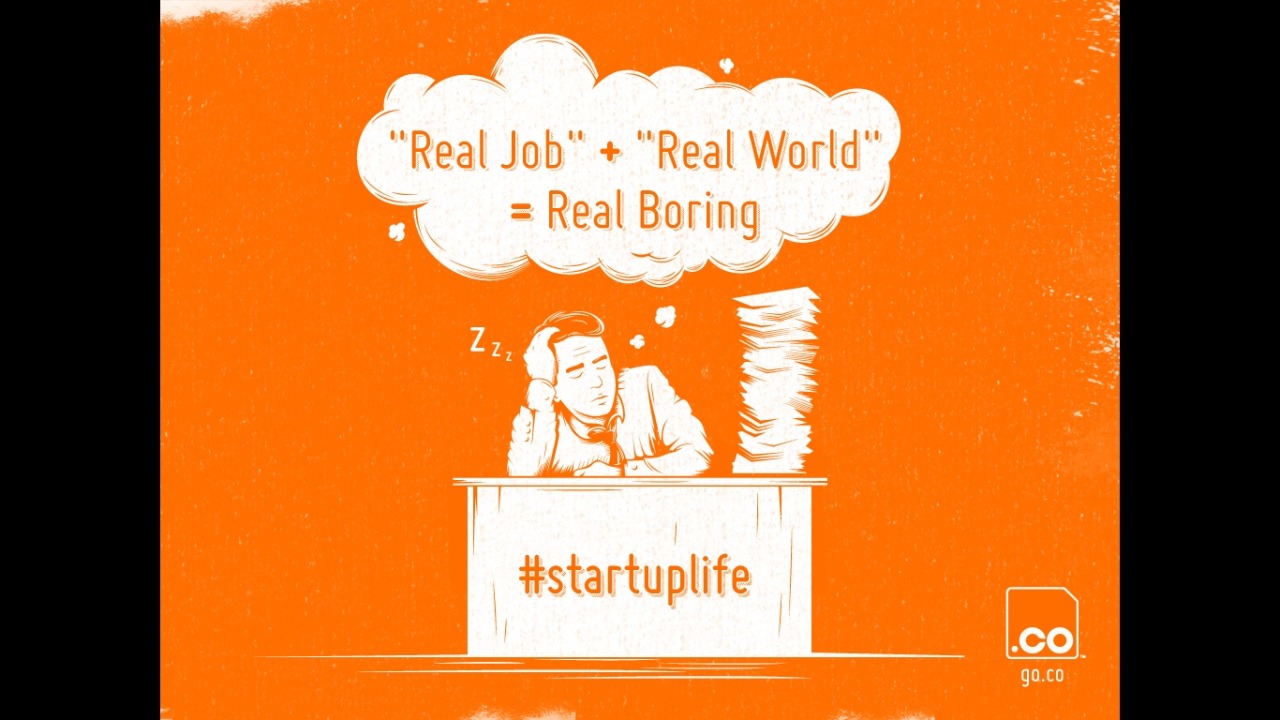
(a) #startuplife by .CO
Are You that Depressed Too?
The problem with performance management is that it rarely captures the complexity of performance dynamics in organizations. It commonly overpasses why performance is ignited in the first place. In other words, it leaves personal and shared purposes out of the equation, being those purposes the primal trigger that separates amateurs from elite performers. It also removes “slack” and “redundancy” in the name of optimization, while ignoring that this “adipose tissue” might be the difference between dismal performance (and oblivion) versus a deep-rooted-competitive advantage based on innovation.
FIRST PART – LET’S START WITH AN EMPTY GLASS

(b) and (c) by Jeff Youngstrom
Most of the ineffectiveness of the traditional view of performance management is largely due to the phrase itself. We invite you to test this assumption yourself.
Close your eyes and mull over the phrase for a while (performance management, performance management…)
Now take your time, read it aloud and read it again. Imagine the effect it produces when someone says it to another in an office setting. How would a boss interpret this phrase? How would Dilbert interpret this phrase? How would it sound to an employee or an intern or to you? Read between the lines and step in everyone else’s shoes. You can even take your dictionary and break down both words, dedicating some time to each one as if you were looking for a subtle and elusive code. Then, write down your hunches as if you were Darwin at The Galapagos Island.
(Breaking) the Management Code
What did you find? Is there something unusual on it?
Here’s what our fellow Mixer, Bjarte Bogsnes found doing a similar exercise (and triggered an entire grassroots movement here in the MIX):
“… the phrase performance management sends a negative message. What do employees hear in this phrase?
‘If we want good performance, we must manage you.’
Competent and intelligent employees want to be led, not managed. The job of managers should be to create the conditions that allow great performance to take place. This usually means they should lead more, and manage less.”
Do you agree with this assumption? We bet you do. There’s definitely something fishy with the word management sitting next to performance. Hence, as Bjarte suggests, we “should lead more and manage less” (being manage a synonym of control.)
That said, we have arrived to the first practical solution of this hack: to remove the management word out of the model. The glass is half empty now, as follows:
Performance Management
However, what about the other half? Did you find something unusual with performance, too? What would you feel if we tell you that performance holds performance back, and that we should remove it as well?
(Reality) TV and Performance
Don’t get us wrong. We certainly love the word performance, and there is nothing wrong with it per se. The real deal is the weight we have given it across time.
Almost invariably, when we think about performance we think of it in terms of good and bad. This black and white comparison is always there in our minds, always.
Such a line of thought could be helpful for, let’s say, the average spectator of Formula 1, but not so much for the racing team behind the competition or for those hearten explorers, like you, who want to introduce innovation as a broad, day-to-day capability in organizations. For example, let’s imagine Ferrari team had a disastrous race (e.g. their performance was bad). Both of its pilots crashed their cars, and even if they had stayed on track they would not have reached the podium as their times were sustainably slow.
In the eyes of the irate fans of Ferrari, who watched such debacle in TV, both pilots and the entire crew of mechanics should be execrated. However, should Ferrari listen to them and get rid of all these people?
If your automatic answer is yes, chances are that you have caught the “you are fired” fever too, a not so uncommon virus broadcasted via television, where the metamessage is the following:
Good performance and success is about being perfect all the time. If you want to win and climb the business and corporate ladder, you need to show pristine and excellent results. Otherwise, Donald Trump, or some of his elegantly dressed followers will put you on the streets.
That’s the premise of The Apprentice, a reality TV show, which distorts reality more than entertains. We all get (consciously) that this is nothing but an illusion, a marketing product. However, on the unconscious level… it’s a different story. Down there, our reasoning can’t go and say “hey, this is just TV!”, and it is precisely there where the message permeates and adds an unnecessary burden in performance.
If we want to unleash performance, we need then to let people stretch and challenge themselves. It implies letting people make mistakes and stop judging their performance in good/bad terms only. This is something that counters the philosophy of The Apprentice and all the status quo it represents.
The Apprentice is one of those remaining cultural icons that sell us the idea of ruthless leadership, tight control, and deviance intolerance. Avoid this show whenever it’s possible! In fact, avoid TV whenever it’s possible and join us in this crusade of unlearning the ways of (not-so) modern management.
Now, it is time for the second practical solution of this hack: to remove performance as we did with management. There you go, the glass is empty now:
Performance management
SECOND PART – LET’S FILL THE GLASS WITH SOMETHING ELSE

(d) by Lord Scharammi / (e) by Javmorcas
Now that we have dismantled the old and traditional performance management model, we propose you to adopt a new pair of words: contribute and compass. Let’s check out what both stand for:
Contribute: to play a significant part in bringing about an end or result (Merrian-Webster.com.)
Compass: device for determining direction (Merrian-Webster’s Pocket Dictionary, 2006.)
Thus, contribution compass emerges as a new way of perceiving human effort and driving accomplishment.
Contribution Compass in a Bite-Size Envelope
Contribution compass is a navigation device for a new kind of organizational explorers, who no longer rely on traditional performance management models. Primarily centered on the user, this instrument helps both teams and individuals on their path of self-mastery and self-discovery. One of its principal aims is to spot meaningful contributions, which are bound to a personal or shared purpose. Those contributions, as opposed to everyday or inconsequential activities, are not necessarily related to the user’s position in the organization. It also uncovers and promotes failures and other forms of iterations, as they are the basis for serendipity and innovation. Last but not least, it helps visualize where the organization is heading to and the strength of its leadership and innovation capabilities.
While common sense weights and conceive performance as a zero sum game, judging results in terms of good versus bad only, the contribution compass goes beyond and ponders efforts according to its purpose, as Tolkien wrote: “All that is gold does not glitter, not all those who wander are lost.”
Hence, not every bad performance is bad and not every good performance is good either. It all depends on the raison d'être that lies behind every effort or contribution.
Trending Topic: Having no Purpose is the New Bad
Bad performance can be really good if it is tied to a meaningful purpose. In fact, humankind owes its existence to those bad yet meaningful performances. The discovery of America (while trying to find a new way to India), or the penicillin (while cleaning up a laboratory) are two of the most public illustrations of the power of unintended discoveries.
So, let´s celebrate mistakes and join Gary Hamel in his chant: “Thank God for screw-ups. If life had adhered to Six Sigma rules, we’d still be slime.”
THIRD PART – LET´S START HACKING
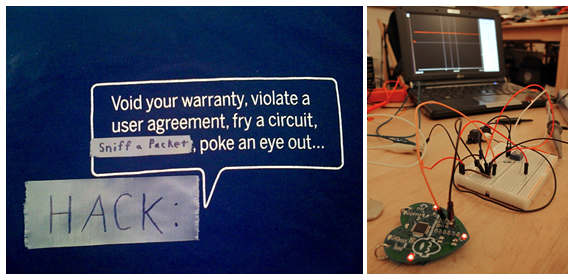
(f) by copyfighting / (g) by Rain Rabbit
Now, it is time for breaking some management bones, and, of course, building up and using your own version of the contribution compass!
Contribution Compass, the Roadmap
This hack has been designed to be completed in five steps, comprised in three dialogues and two actions, as follows:
Step #1 – Uncovering your passion
Step #2 – Intercepting passions
Step #3 – Spotting meaningful contributions
Step #4 – Putting the pieces together
Step #5 - Navigate, ergo innovate
It is important to emphasize that the contribution compass, as a navigation instrument, helps both teams and individuals on their path of self-mastery and self-discovery, as expressed above. If you want to use this device as your personal guide to enhance your skills as both a leader and innovator, you just need to follow this five-step recipe. It is as simple as that. However, if you want to go to the next level…, that is, to really exercise your leadership skills and come up with a robust day-to-day innovative organization, then, you need to inspire, serve, and help others in the process of building and using their own compasses as well.
Minimum Prerequisites
What kind of tools would you need for this endeavor? First and foremost, your inner child will be required from now on. He will provide you with the ingenuity, curiosity, and courage necessary to succeed in the fearsome task of building something from scratch. You may also need a notebook, post-it notes, markers, crayons, and anything else that might let you jot down some absurd and unimaginable ideas.
Bonus: we have prepared for you a contribution compass cheat sheet, where you can upload all your data and automatically get your own compass in no time.
Rediscovering Your Inner Child
If you are not so sure about how to start, here are some prompts that could help you out. The following tips and tricks have been tested and approved for real kiddos and inventors.
Rush to the grocery store and buy lots of chocolates, snacks, and candies. Buy everything you used to love back in your childhood days, but that you weren’t allowed to buy too often (by another rigid and controlling force: your parents -A.K.A, your former bosses-.) Next, go home, as fast as you can (if you use a bicycle or a skateboard you will earn extra creative points.) If you run into someone at home, say a timid “hi” (you may add a small kiss/hug as well) and quickly slip away. Remember, you got an important thing to do, so avoid casual conversations (be polite) and go to your secret and sacred place: that spot in your house that clearly belongs to you and no other than you. It could be your room, your studio, the garage, a deck, and an old-long-forgotten tree house. You name it.
Once in your secret lab, spaceship, or cave, set up a creative mood with your all-time-favorite music, devour your sweets without an inch of remorse, and answer to yourself with utmost sincerity the following:
Do I have a meaningful, passionate, and driving purpose?
Step #1 - Uncovering Your Passion
Personal Purpose
We all have one, an inner itchy that keeps us awake when we are supposed to sleep and lure us to dream, when we are supposed to pay attention in an “important” business meeting. This inner call goes way beyond your role in society. It is that one thing that blurs anything else, paychecks especially.
Do you have yours, don’t you? For some, this personal mission is a clear manifest, a vivid treatise of how to conduct their own lives. For others, it is represented as a subtle, vague, yet recurrent thought that always comes back like a placid wave returning to the shore.
Hence, it doesn’t matter if your mission is for you a three-tome book, an abstract idea, a song, or even a single word. Write it down in your notebook or in the cheat sheet (summarized it in no more than 15 words.)

For Next Level Explorers Only:
Help others come up with their personal purposes. You can share with them your experience in finding yours. Give them some of your remaining (if any) chocolates as an invitation to bring back their childhood. Need some external inspiration? Check out here how Morning Star Company asks everyone to become effective managers of their own mission.
Step #2 – Intercepting Passions
Purpose of the Organization
Start with the mission statement, if there’s one, or uncover it during conversations with your peers. Do we have one? Do we really have one? If so, does it resonate with me? Those are the questions your inquiring soul needs to solve. They will help you state the, sometimes unstated, corporate goal.
When you believe you got it right, write the purpose of the organization in no more than 15 words.
Now that you have identified the organization’s purpose, ask yourself the following four questions and be sure to write your answers in your notebook or in the cheat sheet.
Question #1 - Do you believe the organization’s purpose is worth fighting for? [Yes/No]
Question #2 - Would you recommend any changes to it? [Yes/No]
Question #3 - How much does it overlap yours: 0%, 25%, 50%, 75%, 100%? [Select one option]
Question #4 - Can this overlapping increase? How? [If applicable]
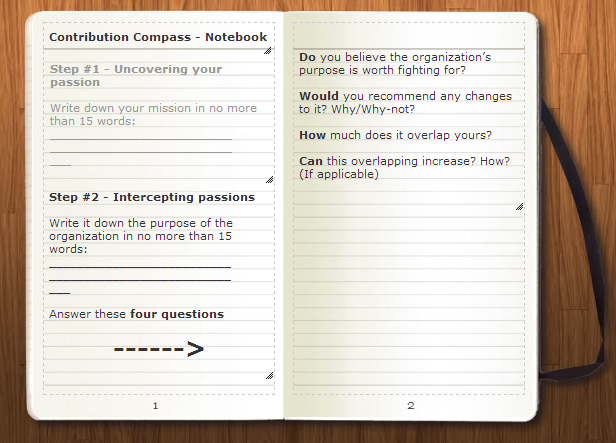
For Next Level Explorers Only:
As with the previous step, encourage your peers to identify and assess the purpose of the organization, as well. In fact, an open discussion with the team or better, the entire organization, can unleash powerful insights. So, go head and embrace the wisdom of crowds (for massive brainstorming sessions you might consider the TweetStorming hack.)
Step #3 – Spotting Meaningful Contributions
Your daily life at work is certainly full of multiple contributions. Some of them are related to your formal role at work, some are not. Take your time to think about all of them.
Now that you have your entire movie in your head, it is time for you to identify from the total of your contributions, which of those are meaningful to you (e.g. those that are closely bounded to your personal or shared purpose) and which are not.
Are they Meaningful or Non-meaningful?
It feels really good when you perform meaningful contributions. Your spirit elevates and you feel proud of what you have done (regardless of the outcome). You want to share the joy with everyone else. If someone asks you, “how was your day at work,” your response would most likely be an upbeat detailed recount of your day.
On the other hand, when your daily routine is based on inconsequential or non-meaningful tasks…, you have “nothing” new to tell the world. If someone asks you about your day, your response might be something like: “it was ok…”
Put Your Findings in Relative Terms
Dear hacker, from the total (i.e. 100%) of your contributions, which percentage does the following categories represents?
Meaningful ___%
Non-meaningful ___%
Write down the results in your notebook keeping in mind that your distribution should sum up 100%. (Later on, in step #5, you will have the chance to play with your results and create some ratios.)
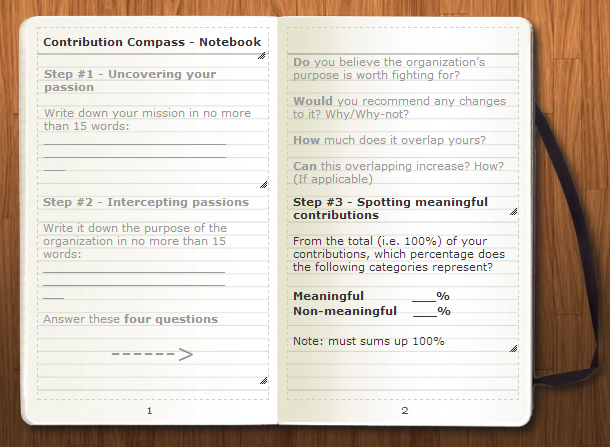
Breaking Down your Meaningful Contributions
Remember our three examples at the very beginning of this hack […winning a football championship (when no one believes in your “underperforming” team), finding a missing girl in the woods (when many abandon all hope), or reinventing your workplace for the sake of innovation (when wise-men tell you that’s stupid and impossible…]?
Well, those miraculous events can be achieved with the right combination of (purposeful) contributions carried out by a cohort of self-driven and inspired actors.
Each of those actors has a specific role, as if we were talking about theatrical play. However, unlike almost any stage representation, which actor plays which role is a matter of choice rather than the result of a casting. This means that, everyone who experiences the urge to fulfill a personal/shared purpose has both the right and the duty to:
a) Play a significant part in bringing about an end or result.
b) Decide which part to play in bringing about an end or result.
Thus, dear hacker and master of your destiny, it is time to reveal which one is your predominant role in bringing about (meaningful) results. In other words, are you mainly a backer (e.g. leader) or an explorer?
In order to give it an answer to that question, let’s review for a moment these three categories of meaningful contributions: Got Your Back, Not Here, and Eureka.
Contribution Type: Got Your Back / Role: Backer
In this type of contributions, true and natural leadership resides, the kind of leadership linked to stewardship more than to nobility titles. Natural leaders are everywhere, and some of their passion is linked to serving and inspiring others.
A got-your-back contributor says “yes, you can” and “you don’t need to ask [my] permission” quite often. Also, natural leaders are generous. They easily share their reservoirs of candy bars and help others in finding their higher call on earth. Then, they step away to let that person shine for his/her own merit.
In the case of our little football team (let’s call them… The Underdogs), some of its natural leaders could be the coach, a person who nudge passion and then step out of the spotlight; its non-official captain, a disciplined water boy, too skinny to be in the field, but with a contagious and strong team-spirit; and, of course, its small yet faithful fan base, who sends waves of willpower through their chants.
In the episode of the poor girl missing in the woods, among the got-your-back contributors are those “strangers” who provide, without asking anything in exchance, blankets, lanterns, flashlights, maps, water, food, and anything else that may support the operation of search and rescue.
In the case of reinventing your workplace for the sake of innovation… that got-your-back contributor could be you.
Contribution Type: Not Here / Role: Explorer
Innovation is a path of discipline, courage, and sometimes, stubbornness. The not-here contributions, being a bunch of purposeful mistakes, are the backbone of all inventions. Hence, note here that contributors are explorers, who don’t ask permission quite often, follow their hunches in a systematic and disciplined way, and are somehow skillful in embracing failure as a catalyst to create new things, and of course, bring about (meaningful) results.
In the case of our friends, The Underdogs, it will take thousands of incomplete passes, sacks, personal faults, failed strategies, and tactics to eventually discover how to beat their foes in the field.
On the other hand, for those courageous explorers, who are deployed in the wild searching for the little girl, a lot of “the girl is not here” contributions are necessary to eventually bring back the joy and reunite a family one more time.
And for you, our stubborn yet visionary management hacker, a scary yet rewarding iterative cycle of prototyping-testing-failing-learning, will help you come up with a renovated, meaningful, and innovative organization.
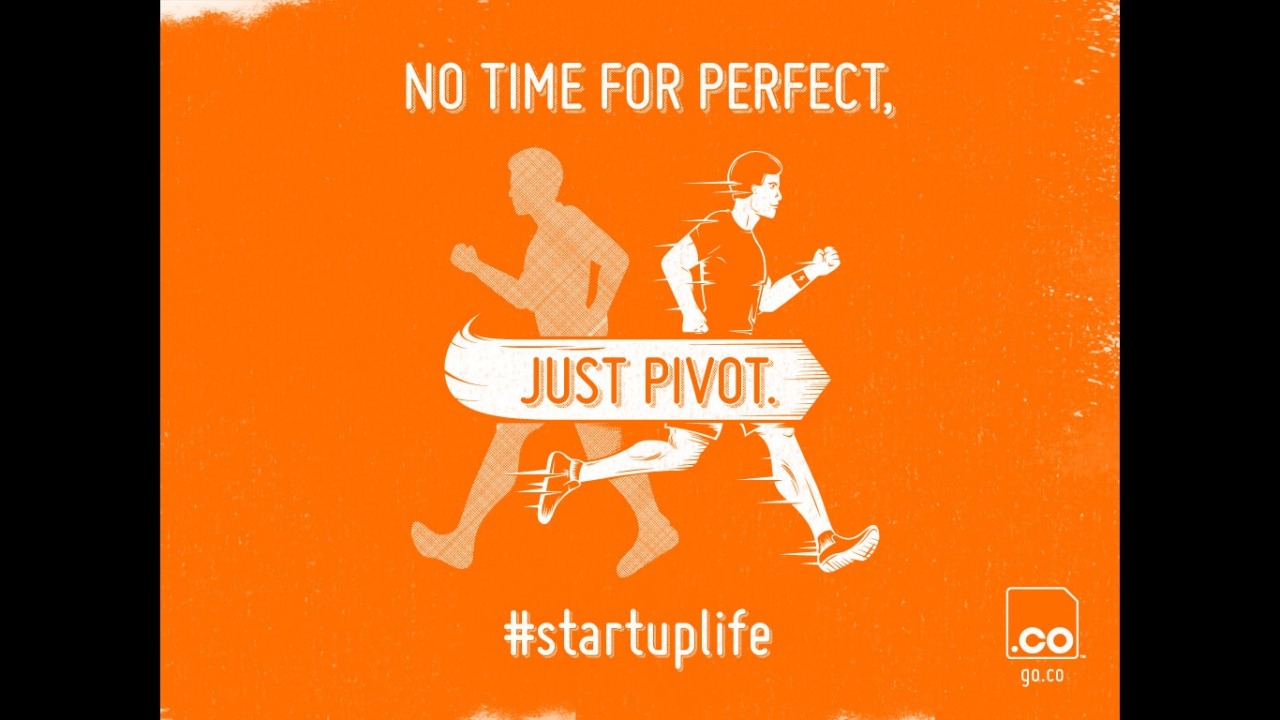
(h) #startuplife by .CO
Contribution Type: Eureka / Role: Explorer
This is the last and least common type of meaningful contributions. In simple terms, eureka contributors are those not-here explorers who got touched by lady luck (e.g. the one who score the winning touchdown, or that one who found the girl -“she’s here, she’s fine!”-.)
Does it really matter who scored that last point or who is the “hero” that now carries the girl in his arms back to her parents? Certainly not. Without an abundant pool of disciplined and not appealing “geez, I’ve blew-up the lab again!” contributions, there would be nothing to celebrate.
Failures matter, especially if they are tied to a purpose. Hence, encourage and celebrate mistakes, iterations, and pivots as much as you celebrate and recognize hallelujah moments.
The Finale (of Step #3)
After knowing the types of meaningful contributions, you are more than ready to tell, from the total (i.e. 100%) of your meaningful contributions, which percentage the following categories represent:
Got Your Back ___%
Not Here ___%
Eureka ___%
As usual, write down the results in your notebook keeping in mind that your distribution should sum up 100%.

Step #4 – Putting the Pieces Together
You have all the data you need to build your navigation instrument. This step is all about summarizing your findings and doing some small and simple calculations. You can have this done for you with the contribution compass cheat sheet.
Step #5 - Navigate, Ergo Innovate
Finally, you are currently at the gates of a journey into the unknown. Be prepared, you will encounter some resistance. Hopefully, this compass will help you trace a path in the middle of the corporate mist, and move from:
... a motionless organization filled with inconsequential contributions, where leadership is less than effective, and innovation occurs in spite of the system…
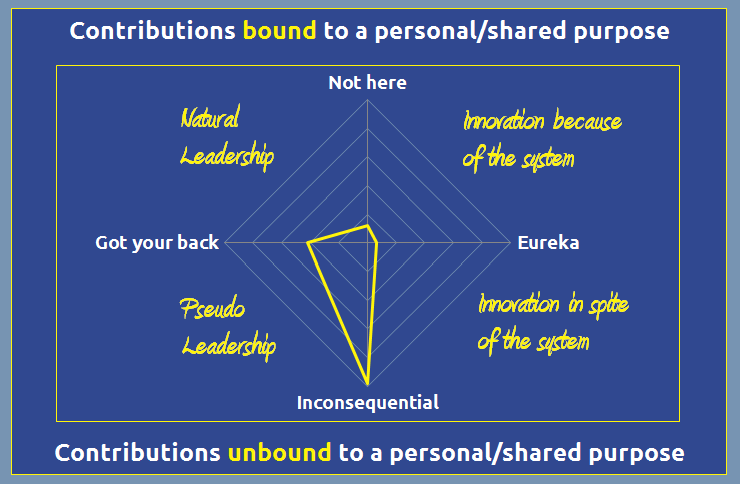
… to a vivid and innovative organization charged with meaning, where leadership actually inspires, and innovation occurs because of the system:
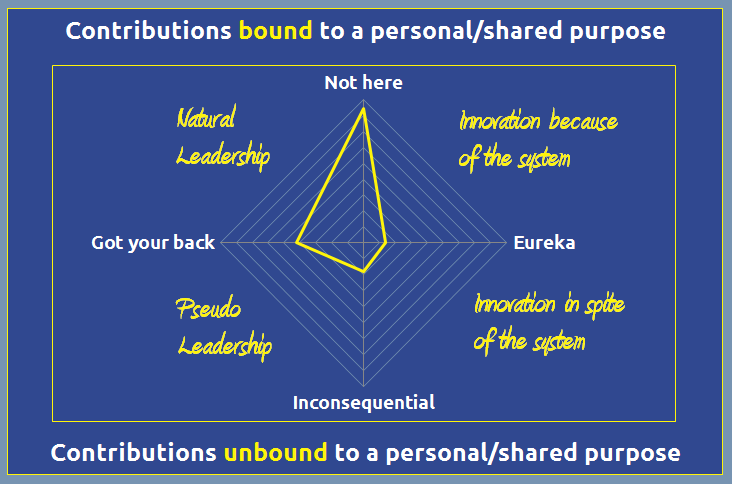
In other words, from:
... little resonance…
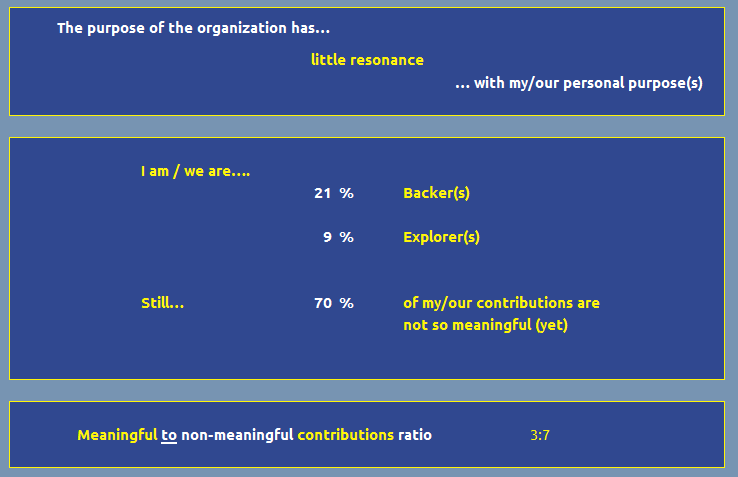
… to full resonance
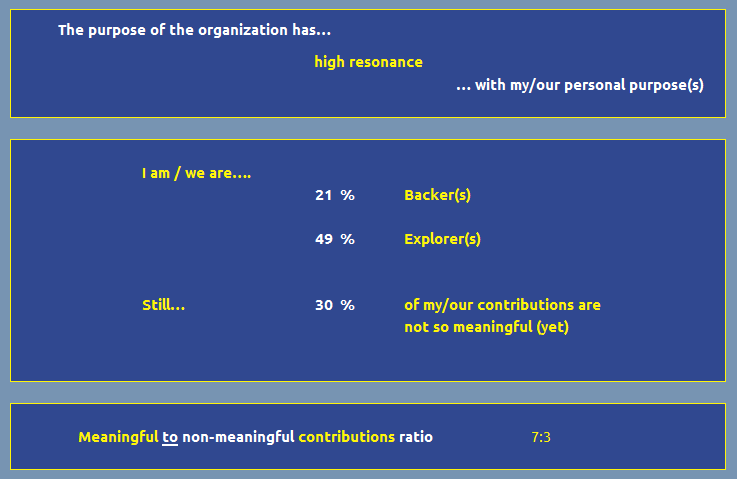
Contribution compass helps you and your company to:
- Concentrate your time in contributions that matter to you and those around.
- Promote and celebrate failures as the backbone of all innovations.
- Provide a litmus test of your leadership capabilities: either your leadership style produces inconsequential contributions (e.g. pseudo leadership), or on the contrary, it produces meaningful contributions (e.g. natural leadership.)
- Nudge forward your innovation capabilities (from innovation in spite of the system to innovation because of the system.)
Build your personal contribution compass first and see what you find. Then, coach your team members or your closest corporate friends to build their own as well. Later on, you can sum up all the results to come up with your team/organization compass. Keep in mind that the contribution compass cheat sheet will give results in no time.
Diana Felibert
Fiona Gifford
Tadas Karkalas
Chris Grams
Bjarte Bogsnes
Johan Prinsloo
Alberto Blanco
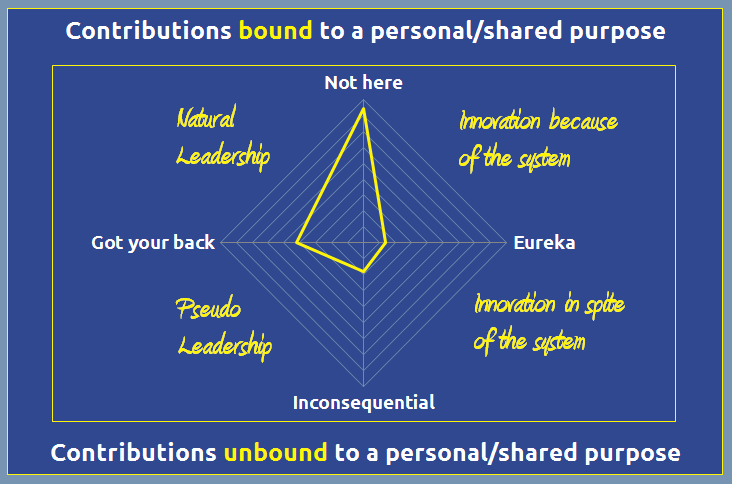
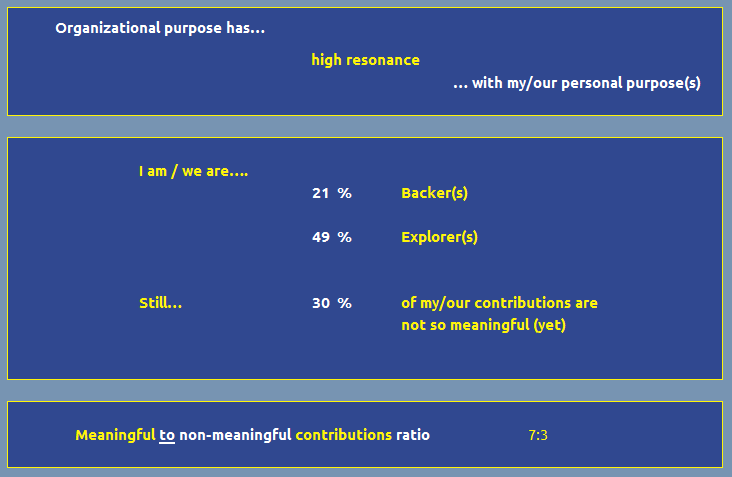
Alberto! I always knew your potential about creating new points of view and turning around some perspectives; but i honestly have to say that you have inspired me to search my own objectives and encounter the lure of my compass.
The analyse of the "you are fired" phylosophy is the essence of what we are doing wrong and what all the companies have to change and reconsider to turn around their inefficacity.
About two monts ago i have graduated of architect and I had been asking myself "What kind of professional do i want to be?" "where is my north?" And your hack had made me belive that my inner child is the correct person to help me find the answer. Next time I'll tell you what we have agreed, no promess about saving some chocolates. Congratulations Al! Keep doing the things right and you will get your reward.
Hugs, Vane
- Log in to post comments
Very inspiring, we can create the world we want. Great thesis Al!
- Log in to post comments
Hi David,
Thanks for your comment and for spreading the word!
All best,
Al
- Log in to post comments






You need to register in order to submit a comment.